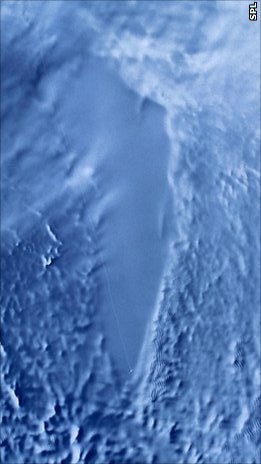冰下湖
冰川下的湖泊 来自维基百科,自由的百科全书
冰下湖(英語:Subglacial lake)是位於冰川下的湖泊,通常位於冰帽或冰蓋下方。由於高壓環境下冰的熔點降低[1][2],上面的冰以每年數毫米的速度逐漸融化[3]。融水流向低水壓區域並形成液態水體,可與外界分隔數百萬年[1][4]。
此條目需要精通或熟悉地球科學的編者參與及協助編輯。 (2024年11月11日) |

自從南極冰蓋下的冰下湖被首次發現以來,南極洲、格陵蘭的冰蓋下方和冰島瓦特納冰原下有400多個冰下湖被發現[5][6][7]。冰下湖佔了地球淡水的一部分,僅南極冰下湖的體積就約有10,000平方公里,約佔地球上液態淡水的15%[8]。
冰下湖的生態系統與地球大氣層隔絕,含有活躍的嗜極微生物群落,能夠適應寒冷和低營養的條件,並促進不受太陽能量輸入的生物地球化學循環[9]。冰下湖及其生物在天體生物學和尋找外星生命領域相當重要[10][11]。
物理特性
由於地熱平衡了冰表面的熱量損失,所以冰下湖中的水能保持液態。上覆冰川的壓力導致水的熔點低於0°C。冰下湖的上限將位於水的壓力熔點與溫度梯度相交的水平處。因此在南極最大的冰下湖沃斯托克湖中,其湖上的冰比周圍的冰蓋厚得多。含高鹽的冰下湖,也因其含鹽量高,而保持液態[12]。
歷史
俄羅斯科學家彼得·克魯泡特金於19世紀末首次提出南極冰蓋下可能存在液態淡水,他認為冰蓋底部的地熱能讓溫度達到冰的熔點[2][13]。俄羅斯冰川學家伊戈爾·A·佐蒂科夫進一步提出了冰蓋下淡水的概念[5]。截至2019年,南極洲有超過400個冰下湖被發現[7],不排除未來還有更多[5]。格陵蘭[6]、冰島和加拿大北部也發現了冰下湖[14]。

為了對南極冰蓋進行廣泛的調查,俄羅斯地理學家兼探險家安德烈·彼得羅維奇·卡皮察在1959年和1964年四次蘇聯南極遠征中,兩次使用地震探測技術繪製了南極洲沃斯托克站下方地層。他收集的數據在30年後被使用,最終發現了位於冰層下的沃斯托克湖[15]。
從1950年代末開始,英國物理學家史丹‧埃文斯(Stan Evans)和戈登‧羅賓(Gordon Robin)開始使用無線電回波探測(英語:radio-echo sounding,RES)的技術來繪製冰厚度圖表[16]。17個冰下湖泊使用此技術被記錄[17]。格陵蘭島第一個冰下湖也被無線電回波探測發現[1]。
1990年代初,來自歐洲遙感衛星ERS-1的雷達高度計資料提供了南極洲至南緯82度的詳細地圖[18],進一步確定了南極冰下湖泊的地理分佈。2005年,勞倫斯·格雷(Laurence Gray)和冰川學家團隊開始根據雷達衛星數據解讀冰層表面的活動,表明冰下可能存在水文活躍的冰下湖[19]。
靜壓密封
冰下湖中的水位可能遠高於地面。理論上,冰下湖甚至可以存在於山頂,只要其上的冰足夠薄以形成所需的靜水密封。浮動水位可以被認為是穿過冰進入湖中的鑽孔中的水位。它相當於在正常冰架上一塊冰漂浮的高度。當湖周圍的冰層太厚以至於等位面下降到不透水的地面時,就會形成靜水密封。然後,冰緣下方的水被靜壓密封壓回湖中。據估計,沃斯托克湖的冰緣只有7米,而浮面則高出湖面約3公里[20]。
參考文獻
Wikiwand - on
Seamless Wikipedia browsing. On steroids.
